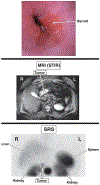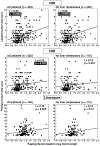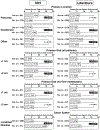Serum gastrin in Zollinger-Ellison syndrome: I. Prospective study of fasting serum gastrin in 309 patients from the National Institutes of Health and comparison with 2229 cases from the literature
- PMID: 17108778
- PMCID: PMC9806863
- DOI: 10.1097/01.md.0000236956.74128.76
Serum gastrin in Zollinger-Ellison syndrome: I. Prospective study of fasting serum gastrin in 309 patients from the National Institutes of Health and comparison with 2229 cases from the literature
Abstract
The assessment of fasting serum gastrin (FSG) is essential for the diagnosis and management of patients with the Zollinger-Ellison syndrome (ZES). Although many studies have analyzed FSG levels in patients with gastrinoma, limited information has resulted from these studies because of their small size, different methodologies, and lack of correlations of FSG levels with clinical, laboratory, or tumor features in ZES patients. To address this issue, we report the results of a prospective National Institutes of Health (NIH) study of 309 patients with ZES and compare our results with those of 2229 ZES patients in 513 small series and case reports in the literature. In the NIH and literature ZES patients, normal FSG values were uncommon (0.3%-3%), as were very high FSG levels >100-fold normal (4.9%-9%). Two-thirds of gastrinoma patients had FSG values <10-fold normal that overlap with gastrin levels seen in more common conditions, like Helicobacter pylori infection or antral G-cell hyperplasia/hyperfunction. In these patients, FSG levels are not diagnostic of ZES, and gastrin provocative tests are needed to establish the diagnosis. Most clinical variables (multiple endocrine neoplasia type 1 status, presence or absence of the most common symptoms, prior medical treatment) are not correlated with FSG levels, while a good correlation of FSG values was found with other clinical features (prior gastric surgery, diarrhea, duration from onset to diagnosis). Increasing basal acid output, but not maximal acid output correlated closely with increasing FSG. Numerous tumoral features correlated with the magnitude of FSG in our study, including tumor location (pancreatic > duodenal), primary size (larger > smaller) and extent (liver metastases > local disease). In conclusion, this detailed analysis of FSG in a large number of patients with ZES allowed us to identify important clinical guidelines that should contribute to improved diagnosis and management of patients with ZES.
Figures





References
-
- Aabo K, Romond E, Dimitrov NV, Denny TN, Suhrland LG. Pancreatic islet cell carcinoma associated with multiple hormone secretion and pancytopenia. Evidence of a serum factor suppressing hematopoiesis. Cancer. 1983;51:1691–1696. - PubMed
-
- Abbey-Toby A, Vullierme MP, Sauvanet A, Ruszniewski P, Bedossa P, Couvelard A. A clear cell malignant gastrinoma of the pancreas with cytoplasmic accumulation of lipid droplets. Virchows Arch. 2005;1–2. - PubMed
-
- Abboud P, Bart H, Mansour G, Pinteaux A, Birembaut P. Ovarian gastrinoma in multiple endocrine neoplasia type I: A case report. Am J Obstet Gynecol. 2001;184:237–238. - PubMed
-
- Abou-Saif A, Lei J, McDonald TJ, Chakrabarti S, Waxman I, Shojamanesh H, Schrump DS, Kleiner DE, Gibril F, Jensen RT. A new cause of Zollinger-Ellison syndrome: non-small cell lung cancer. Gastroenterology. 2001;120:1271–1278. - PubMed
-
- Ahlman H, Tisell L-E. The use of a long-acting somatostatin analogue in the treatment of advanced endocrine malignancies with gastrointestinal symptoms. Scand J Gastroenterol. 1987;22:938–942. - PubMed
Publication types
MeSH terms
Substances
Grants and funding
LinkOut - more resources
Full Text Sources
Medical

